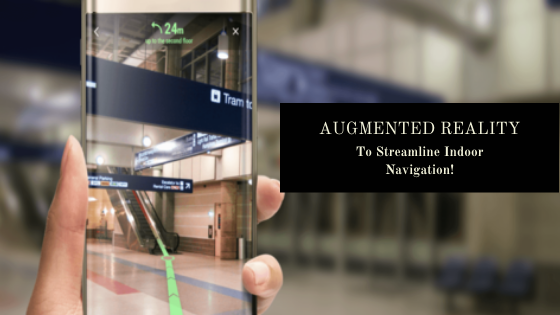
Can Augmented Reality (AR) Streamline Indoor Navigation in 2022?
Can Augmented Reality (AR) Streamline Indoor Navigation in 2022?
The potential applications for augmented reality tech are numerous, and one of the most in-demand products on the horizon is indoor navigation.
Applicable to many sprawling venues that see significant indoor foot-traffic like stadiums, malls, and airports, indoor navigation will continue to see a rising need as the technology matures. Current so-called augmented reality indoor wayfinding solutions look good on the aesthetic surface, but lack true navigation features as augmented reality is used for route visualization only.
However, it’s possible to leverage Apple and Google augmented reality frameworks for solving the problem of user positioning accuracy and take indoor navigation technology to the next level.
Potential Solutions to Streamline Indoor Navigation with AR
GPS navigation is already a feature many of us make use of on a day-to-day basis and it works wonderfully in the majority of outdoor navigation scenarios with accuracy of about 5 meters, but starts to show faults when brought indoors.
This is particularly noticeable in multi-level buildings or tightly-packed venues with lots of elevation changes. Most vertical positioning indoors has to be performed manually – an inconvenient nuisance at best, and a confusing exercise in frustration for lost travelers at worst.
1. Beacon-based Navigation needs Accuracy Enhancement
Another solution already seeing use comes in the form of Bluetooth Low Energy (BLE) beacons.
Beacon technology is mainly being deployed by retailers as a way to push marketing information to shoppers who approach close enough to the shops, usually 10-100 meters, for beacons to catch the visitor device. Some department stores went a step further to make use of beacons to both help visitors with navigation and to also provide location-focused advertisements.
One of the biggest hurdles to overcome when it comes to beacon based indoor navigation is the demand for strict accuracy when it comes to mapping indoor locations. Beacon-based solutions can only maintain accuracy down to within about 5-6 meters – enough for Gatwick airport or Target, but not enough for a smaller retail or office building.
To position a user, a pack of three and more beacons is needed to apply a trilateration algorithm, i.e. a measure of the distance from three fixed points. Adding the cost of around $10-20 per beacon, and a requirement for battery replacement, these devices have the potential to fall short in serious consideration for accurate indoor navigation.
2. Wi-Fi Networks help Navigation
A traditional Wi-Fi positioning system (WPS) utilized in airports and large venues uses signal strength as an indicator of distance. This is a crude and inaccurate solution for measuring distance, with the actual distance varying up to 15 meters from the target point.
This obviously creates some pretty serious drawbacks for indoor navigation cases which need more precise accuracy. With the adoption of the Wi-Fi RTT standard (IEE 802.11mc) business will leverage true point-to-point indoor navigation.
3. Augmented Reality enters the Scene
Augmented Reality technology has been leveraged in many business domains from the retail industry to medicine and education. Indoor navigation systems, which use Augmented Reality for a user’s positioning, are an innovative application of the technology.
The method is called AR marker-based indoor positioning. A visual marker is a real world image placed somewhere in a building, scanned by a visitor, then recognized by an augmented reality software and used as a place where to start a virtual route to the desired destination.
Final Thoughts
Both B2C and B2B companies can integrate an AR-enabled navigation feature into their apps. Guiding visitors and shoppers inside of airports, museums, hospitals or shopping malls will enhance the customer experience, contributing to brand loyalty. Helping staff with navigating around the offices and warehouses will contribute to the enhancement of internal company processes.
In May 2019, the number of AR-compatible devices in the world reached 1.05 billion. The AR software and hardware evolutionary improvements, like Apple’s ARKit 3.0 and A13 chip in iPhone 11, or AR walking directions feature for Google Maps, will contribute to the technology maturity in 2022.
This should improve the accuracy of indoor navigation and allow for more complex solutions.
